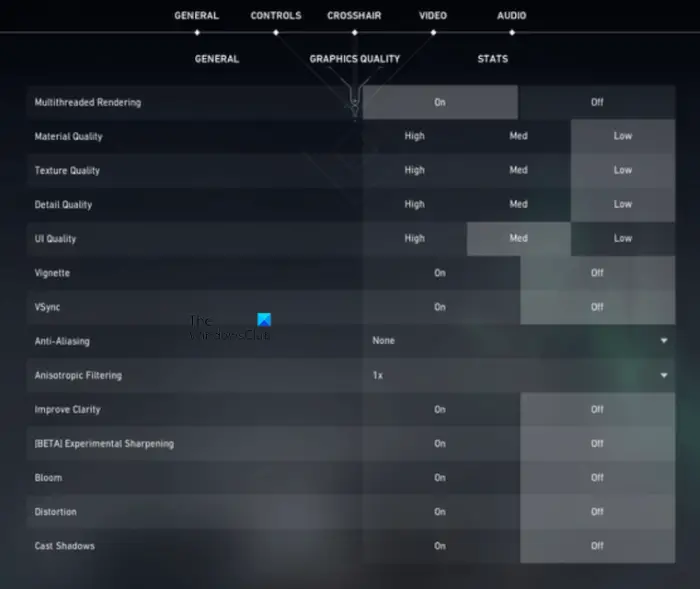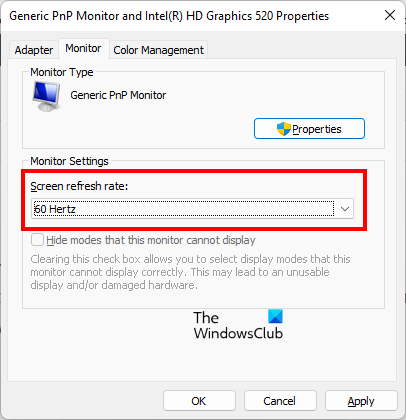If you are experiencing input lag in Valorant, you can try the solutions to fix the problem. When we input our computer, the GPU displays the required output on the screen. Input lag or latency occurs when the computer displays the output a few seconds after the input given by the user. Due to this issue, gamers cannot play the game properly. In this article, we will discuss some ways to fix Valorant input lag and reduce latency.

How to fix Input Lag and Reduce Latency in VALORANT
Try the following solutions to fix Valorant input lag and reduce latency in Windows 11/10:
- Try a wired mouse and keyboard
- Configure Valorant Settings to get maximum FPS
- Disable full-screen optimization in Valorant
- Disable VSync
- Update or reinstall your GPU driver
- Set the maximum refresh rate of your monitor
- Update your system BIOS
Let’s see all these solutions in detail.
1] Try a wired mouse and keyboard
Usually, wireless keyboards and mice have a high latency as compared to wired keyboards and mice. Therefore, if you are using a wireless keyboard or mouse, switch to a wired one and see if an input lag occurs in Valorant or not.
2] Configure Valorant settings to get maximum FPS
Increasing the FPS (Frames per Second) can lower the input lag. To fix the problem of input lag, you can do one of the following things:
- Limit the FPS of your game that matches the maximum refresh rate of your monitor.
- Increase the FPS in your game and make it double the monitor’s refresh rate or higher than that.
First, try the former method. If it does not help, increase your game FPS. The second method will put a strain on your graphics card but is more likely to resolve the issue. You can install free FPS counter software to measure your game FPS.
There are some tweaks that are common for all games to get the maximum FPS.

Below, we have mentioned some settings in Valorant that you can configure in order to get the maximum FPS.
- Turn off the Show Corpses and Show Blood in Video settings.
- Select a low game resolution and set the Display Mode to Fullscreen.
- Enable the Multithreaded Rendering. You will find this option in the Video settings. Enabling this feature will make Valprant fully utilize your GPU and CPU in order to give you the best performance.
- Turn off the following options:
- Vignette
- Improve Clarity
- Experimental Sharpening
- Bloom
- Distortion
- Cast Shadows
After configuring the above settings in Valorant, the FPS will increase in Valorant which will decrease the input lag to some extent.
Input lag also occurs if your hardware is not capable of running a particular program or if your system has only the minimum hardware requirements. The permanent solution to fix this problem is upgrading your hardware.
3] Disable full-screen optimization in Valorant
Disabling the full-screen optimization in Valorant has fixed the issue for some users. You can also try this. To do so, go to the following location:
C:\Riot Games\VALORANT\live\ShooterGame\Binaries\Win64
Now, right-click on VALORANT-Win64-Shipping.exe and select properties. After that, navigate to the Compatibility tab. If an option to disable the full-screen optimization is available there, turn on that option.
4] Disable VSync
VSync is a technology that fixes the screen tearing issues in video games. The screen tearing in a video game occurs when the refresh rate of the monitor and FPS go out of sync. It is a myth that higher FPS causes screen tearing. Screen tearing can occur at any frame rate.
If you have enabled VSync, you may suffer from input lag. This is because VSync adds a delay between the GPU rendering frames and these frames being displayed on the screen. Hence, to fix the input delay in your game, you should turn off VSync.
If you experience a screen tearing issue after turning off VSync, setting the frame rate in your game in the multiple of the monitor’s refresh rate can help.
5] Update or reinstall your GPU driver
The input lag or input delay depends on how fast the graphics card renders the images and displays them on the screen. Therefore, it is necessary to keep your graphics card driver up to date. Go to the Optional Updates page in your Windows 11/10 Settings and see if an update for your graphics card driver is available there. If yes, install it. This should help.
You can also try reinstalling the graphics card driver. To do so, first, download the latest version of your graphics card driver from the manufacturer’s website and then follow the steps provided below:
- Open the Device Manager.
- Expand the Display adapters node. You will see your graphics card driver there.
- Right-click on your graphics card driver and select Uninstall device.
- Now, run the installer file that you have downloaded from the manufacturer’s website and follow the on-screen wizard to install the graphics card driver manually.
6] Set the maximum refresh rate of your monitor
Your monitor’s display settings may increase the time between the input commands and displaying the output. The hardware settings cannot be changed but there are some software tweaks that you can do to lower the input lag. Set the refresh rate of your monitor to the maximum. The steps for the same are written below:

- Open Windows 11/10 Settings.
- Go to “System > Display > Advanced Display.”
- Select your display from the drop-down.
- Click on the “Display adapter properties for Display #.” Here # represents the Display number.
- Now, select the Monitor tab.
- Click on the Screen refresh rate in the drop-down and select the maximum value.
- Click Apply and then click OK.
The higher refresh rate will increase the number of frames that your monitor displays per second which helps reduce the input lag.
7] Update your system BIOS
Some users were able to fix the problem by updating the BIOS of their system. You can also try this if none of the above solutions fixed the issue.
Read: How to fix VALORANT High Memory and CPU usage
How do I fix input lag?
The input lag can occur due to outdated or corrupted graphics card drivers. Therefore, it is necessary to keep your drivers updated. If you are experiencing a lagging issue with your keyboard, the Keyboard Troubleshooter can help fix the problem. If you are using a wireless keyboard and mouse, it will be better if you switch to wired ones.
Why is Valorant so laggy?
If your system does not have supported hardware, you will experience input lag in Valorant and other games. Latency is of two types, network latency, and peripheral latency. Network latency occurs due to network issues. On the other hand, Peripheral latency occurs due to many reasons, like corrupted or outdated graphics card driver, incorrect in-game settings, enabled VSync, etc.
Read next: Valorant crashing Mid Game or on Startup.
Leave a Reply